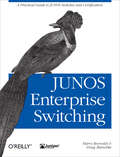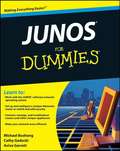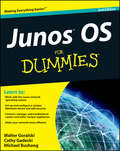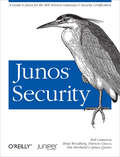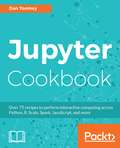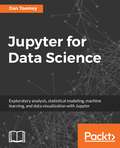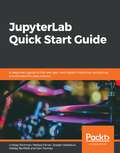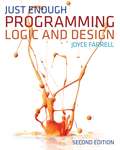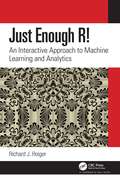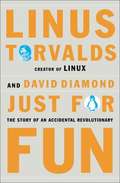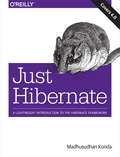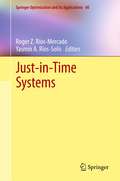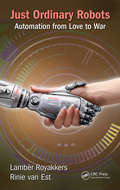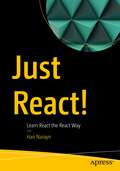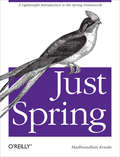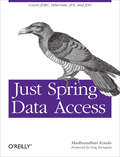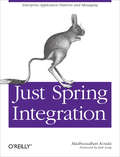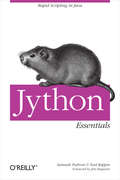- Table View
- List View
JUNOS Enterprise Switching: A Practical Guide to JUNOS Switches and Certification
by Harry Reynolds Doug MarschkeJUNOS Enterprise Switching is the only detailed technical book on Juniper Networks' new Ethernet-switching EX product platform. With this book, you'll learn all about the hardware and ASIC design prowess of the EX platform, as well as the JUNOS Software that powers it. Not only is this extremely practical book a useful, hands-on manual to the EX platform, it also makes an excellent study guide for certification exams in the JNTCP enterprise tracks. The authors have based JUNOS Enterprise Switching on their own Juniper training practices and programs, as well as the configuration, maintenance, and troubleshooting guidelines they created for their bestselling companion book, JUNOS Enterprise Routing. Using a mix of test cases, case studies, use cases, and tangential answers to real-world problems, this book covers:Enterprise switching and virtual LANs (VLANs) The Spanning tree protocol and why it's needed Inter-VLAN routing, including route tables and preferences Routing policy and firewall filters Switching security, such as DHCP snooping Telephony integration, including VLAN voice Part of the Juniper Networks Technical Library, JUNOS Enterprise Switching provides all-inclusive coverage of the Juniper Networks EX product platform, including architecture and packet flow, management options, user interface options, and complete details on JUNOS switch deployment.
JUNOS For Dummies
by Michael Bushong Cathy Gadecki Aviva GarrettIf you're in charge of a network, you're probably aware that the only time anyone notices the network is when it goes down. With JUNOS software and JUNOS For Dummies, a friendly book to help you set it up and manage the software, you might be able to start convincing your clients to believe in magic. Here's the help you need for switching, routing, security, interface configuration, and more. Now, you can go inside JUNOS software and understand everything you need to know about operating a network with JUNOS. You'll learn how the control plane handles packet delivery and establishes traffic policies and see how a single network operating system can add stability and reliability while saving administrative time. Plus, you'll find out how to set up a routing protocol that automates configuration of routing tables for greater efficiency and how you can set up individual or group user accounts locally on the route, or on remote centralized authentication servers. By the time you finish this book, you'll know how to: Work with the JUNOS network operating system Set up and configure a Juniper router Connect, manage, and troubleshoot routers and other Juniper appliances Make your network more efficient Configure JUNOS default security features as well as restricted physical access to protect routers Solve hardware, software, interface, and router problems Integrate JUNOS with other systems Complete with lists of the most useful commands, IOS-JUNOS command conversions, and the best place to seek additional help, JUNOSFor Dummies is your one-stop guide to getting started with and mastering JUNOS.
JUNOS High Availability: Best Practices for High Network Uptime (Animal Guide)
by James Sonderegger Orin Blomberg Kieran Milne Senad PalislamovicWhether your network is a complex carrier or just a few machines supporting a small enterprise, JUNOS High Availability will help you build reliable and resilient networks that include Juniper Networks devices. With this book's valuable advice on software upgrades, scalability, remote network monitoring and management, high-availability protocols such as VRRP, and more, you'll have your network uptime at the five, six, or even seven nines -- or 99.99999% of the time. Rather than focus on "greenfield" designs, the authors explain how to intelligently modify multi-vendor networks. You'll learn to adapt new devices to existing protocols and platforms, and deploy continuous systems even when reporting scheduled downtime. JUNOS High Availability will help you save time and money. Manage network equipment with Best Common Practices Enhance scalability by adjusting network designs and protocols Combine the IGP and BGP networks of two merging companies Perform network audits Identify JUNOScripting techniques to maintain high availability Secure network equipment against breaches, and contain DoS attacks Automate network configuration through specific strategies and tools This book is a core part of the Juniper Networks Technical LibraryTM.
JUNOS OS For Dummies
by Michael Bushong Walter J. Goralski Cathy GadeckiLearn to use JUNOS to make your network reliable!Providing network administrators with a reliable network operating system, JUNOS software is an award-winning network operating system that focuses on security and the avoidance of down time. This easy-to-understand book starts with the basics of JUNOS and walks you through its features so that you can quickly learn how to set up, operate, and add key services.Since the various JUNOS features are constantly being updated to provide your network with the best security possible, this new edition shares must-know information, helpful advice, handy tips, and essential cautions for working with JUNOS. Plus, you'll find out how to set up a routing protocol that automates configuration of routing tables for greater efficiency and how you can set up individual or group user accounts locally on the route, or on remote centralized authentication servers.Starts with the basics and introduces you to JUNOSExplains how to connect, manage, and troubleshoot routers and other Juniper appliancesOffers tips for making your network more efficient and reveals essential cautionsWalks you through setting up, operating, and adding key servicesDetails ways to configure JUNOS default security features as well as restricted physical access to protect routersBreaks down advanced concepts into easy-to-understand segments so you can build your knowledge graduallyThis new edition gets you started using the sophisticated features and techniques of JUNOS today.
Junos Security: A Guide to Junos for the SRX Services Gateways and Security Certification
by Patricio Giecco Timothy Eberhard Rob Cameron James Quinn Brad WoodbergJunos® Security is the complete and authorized introduction to the new Juniper Networks SRX hardware series. This book not only provides a practical, hands-on field guide to deploying, configuring, and operating SRX, it also serves as a reference to help you prepare for any of the Junos Security Certification examinations offered by Juniper Networks. Network administrators and security professionals will learn how to use SRX Junos services gateways to address an array of enterprise data network requirements -- including IP routing, intrusion detection, attack mitigation, unified threat management, and WAN acceleration. Junos Security is a clear and detailed roadmap to the SRX product lines. Get up to speed on Juniper's multi-function SRX platforms and SRX Junos software Explore case studies and troubleshooting tips from engineers with extensive SRX experience Become familiar with SRX security policy, Network Address Translation, and IPSec VPN configuration Learn about routing fundamentals and high availability with SRX platforms Discover what sets SRX apart from typical firewalls Understand the operating system that spans the entire Juniper Networks networking hardware portfolio Learn about the more commonly deployed branch series SRX as well as the large Data Center SRX firewalls "I know these authors well. They are out there in the field applying the SRX's industry-leading network security to real world customers everyday. You could not learn from a more talented team of security engineers." --Mark Bauhaus, EVP and General Manager, Juniper Networks
Jupyter Cookbook: Over 75 recipes to perform interactive computing across Python, R, Scala, Spark, JavaScript, and more
by Dan ToomeyLeverage the power of the popular Jupyter notebooks to simplify your data science tasks without any hassleKey FeaturesCreate and share interactive documents with live code, text and visualizationsIntegrate popular programming languages such as Python, R, Julia, Scala with JupyterDevelop your widgets and interactive dashboards with these innovative recipesBook DescriptionJupyter has garnered a strong interest in the data science community of late, as it makes common data processing and analysis tasks much simpler. This book is for data science professionals who want to master various tasks related to Jupyter to create efficient, easy-to-share, scientific applications.The book starts with recipes on installing and running the Jupyter Notebook system on various platforms and configuring the various packages that can be used with it. You will then see how you can implement different programming languages and frameworks, such as Python, R, Julia, JavaScript, Scala, and Spark on your Jupyter Notebook. This book contains intuitive recipes on building interactive widgets to manipulate and visualize data in real time, sharing your code, creating a multi-user environment, and organizing your notebook. You will then get hands-on experience with Jupyter Labs, microservices, and deploying them on the web. By the end of this book, you will have taken your knowledge of Jupyter to the next level to perform all key tasks associated with it.What you will learnInstall Jupyter and configure engines for Python, R, Scala and moreAccess and retrieve data on Jupyter NotebooksCreate interactive visualizations and dashboards for different scenariosConvert and share your dynamic codes using HTML, JavaScript, Docker, and moreCreate custom user data interactions using various Jupyter widgetsManage user authentication and file permissionsInteract with Big Data to perform numerical computing and statistical modelingGet familiar with Jupyter's next-gen user interface - JupyterLabWho this book is forThis cookbook is for data science professionals, developers, technical data analysts, and programmers who want to execute technical coding, visualize output, and do scientific computing in one tool. Prior understanding of data science concepts will be helpful, but not mandatory, to use this book.
Jupyter for Data Science
by Dan ToomeyThis book is meant for students as well as professionals, who wish to master the use of Jupyter to perform a variety of data science tasks. Some programming experience with R or Python, and some basic understanding of Jupyter is all you need to get started with this book.
JupyterLab Quick Start Guide: A beginner's guide to the next-gen, web-based interactive computing environment for data science
by Lindsay Richman Melissa Ferrari Joseph Oladokun Wesley Banfield Dan ToomeyGet to grips with the basics of JupyterLab and its web interface with the help of this quick start guide Key Features Manage JupyterLab kernels, code consoles, and terminals, and share your work over the cloud Organize your data solutions within JupyterLab Install and configure extensions on JupyterLab using easy-to-follow examples Book Description JupyterLab is a web-based interface and the natural evolution of Jupyter Notebook. This guide will take you through the core commands and functionalities of JupyterLab and help you enhance your JupyterLab productivity. Starting with the installation of JupyterLab, this book will give you an overview of its features and the variety of problems it solves. You'll see how you can work with external files inside the platform, and understand how to use the code console and terminal. This will help you have distinct control over the scripts you work with. As you progress, you'll get to grips with the extensions available in JupyterLab, and gain insights into adding extensions to introduce new functionality in the interface. This book also covers widget operations within your document, different design patterns in JupyterLab, and the various methods for exchanging Notebooks. Additionally, you'll explore how to host JupyterLab Notebooks on GitHub. By the end of this Jupyter book, you'll have become well-versed with all the components of JupyterLab and be able to use it collaboratively within your data science teams. What you will learn Install JupyterLab and work with Jupyter Notebooks Host JupyterLab Notebooks on GitHub and access GitHub resources in your Notebooks Explore different methods for exchanging Notebooks Discover ways in which multiple users can access the same Notebook Publish your Notebooks with nbviewer and convert them into different formats Attach and operate widgets within your Notebooks using a JupyterLab document Use JupyterLab to work collaboratively with multiple data scientists in your teams Who this book is for This book is for data scientists and data analysts who are new to JupyterLab as well as for existing Jupyter users who want to get acquainted with its impressive features. Although not necessary, basic knowledge of Python will be helpful.
Just a Geek
by Wil WheatonWil Wheaton has never been one to take the conventional path to success. Despite early stardom through his childhood role in the motion picture "Stand By Me", and growing up on television as Wesley Crusher on "Star Trek: The Next Generation", Wil left Hollywood in pursuit of happiness, purpose, and a viable means of paying the bills. In the oddest of places, Topeka, Kansas, Wil discovered that despite his claims to fame, he was at heart Just a Geek. In this bestselling book, Wil shares his deeply personal and difficult journey to find himself. You'll understand the rigors, and joys, of Wil's rediscovering of himself, as he comes to terms with what it means to be famous, or, ironically, famous for once having been famous. Writing with honesty and disarming humanity, Wil touches on the frustrations associated with his acting career, his inability to distance himself from Ensign Crusher in the public's eyes, the launch of his incredibly successful web site, wilwheaton.net, and the joy he's found in writing. Through all of this, Wil shares the ups and downs he encountered along the journey, along with the support and love he discovered from his friends and family. The stories in Just a Geek include: Wil's plunge from teen star to struggling actor Discovering the joys of HTML, blogging, Linux, and web design The struggle between Wesley Crusher, Starfleet ensign, and Wil Wheaton, author and blogger Gut-wrenching reactions to the 9-11 disaster Moving tales of Wil's relationships with his wife, step-children, and extended family The transition from a B-list actor to an A-list authorWil Wheaton--celebrity, blogger, and geek--writes for the geek in all of us. Engaging, witty, and pleasantly self-deprecating, Just a Geek will surprise you and make you laugh.
Just a Journalist: On the Press, Life, and the Spaces Between (The William E. Massey Sr. lectures in American studies ; #2015)
by Linda GreenhouseA Pulitzer Prize–winning reporter who covered the Supreme Court for The New York Times, Linda Greenhouse trains an autobiographical lens on a moment of transition in U.S. journalism. Calling herself “an accidental activist,” she raises urgent questions about the role of journalists as citizens and participants in the world around them.
Just Enough Programming Logic and Design
by Joyce FarrellFind exactly what you need to master the fundamentals of programming logic with the concise JUST ENOUGH PROGRAMMING LOGIC AND DESIGN, 2E. This unique, language-independent introduction to programming logic provides seven chapters focused on key programming and logic content in a direct, efficient format that helps you progress through the subject matter quickly. Everyday examples and clear explanations in a streamlined presentation make this a perfect choice even if you have no prior programming experience. Twenty-five brief new videos from the author expand on and clarify topics, while new Debugging Exercises and a wealth of review and programming exercises in each chapter help you hone your skills. You can use this concise approach alone or as a companion book for success in any programming language course.
Just Enough R!: An Interactive Approach to Machine Learning and Analytics
by Richard J. RoigerJust Enough R! An Interactive Approach to Machine Learning and Analytics presents just enough of the R language, machine learning algorithms, statistical methodology, and analytics for the reader to learn how to find interesting structure in data. The approach might be called "seeing then doing" as it first gives step-by-step explanations using simple, understandable examples of how the various machine learning algorithms work independent of any programming language. This is followed by detailed scripts written in R that apply the algorithms to solve nontrivial problems with real data. The script code is provided, allowing the reader to execute the scripts as they study the explanations given in the text. Features Gets you quickly using R as a problem-solving tool Uses RStudio’s integrated development environment Shows how to interface R with SQLite Includes examples using R’s Rattle graphical user interface Requires no prior knowledge of R, machine learning, or computer programming Offers over 50 scripts written in R, including several problem-solving templates that, with slight modification, can be used again and again Covers the most popular machine learning techniques, including ensemble-based methods and logistic regression Includes end-of-chapter exercises, many of which can be solved by modifying existing scripts Includes datasets from several areas, including business, health and medicine, and science About the Author Richard J. Roiger is a professor emeritus at Minnesota State University, Mankato, where he taught and performed research in the Computer and Information Science Department for over 30 years.
Just for Fun: The Story of an Accidental Revolutionary
by Linus Torvalds David DiamondIn a narrative that zips along with the speed of e-mail, Torvalds gives a history of his renegade software while candidly revealing the quirky mind of a genius.
Just Hibernate
by Madhusudhan KondaIf you're looking for a short, sweet, and simple introduction (or reintroduction) to Hibernate, this is the book you want. Through clear real-world examples, you'll learn Hibernate and object-relational mapping from the ground up, starting with the basics. Then you'll dive into the framework's moving parts to understand how they work in action.Storing Java objects in relational databases is usually a challenging and complex task for any Java developer, experienced or not. This book, like others in the Just series, delivers a concise, example-driven tutorial for Java beginners. You'll gain enough knowledge and confidence to start working on real-world projects with Hibernate.Compare how JDBC and Hibernate work with object persistenceLearn how annotations are used to create Hibernate applicationsUnderstand how to persist and retrieve Java data structuresFocus on the fundamentals of associations and their mappingsDelve into advanced concepts such as caching, inheritance, and typesWalk through the Hibernate Query Language API, with examplesDevelop Java Persistence API applications, using Hibernate as the providerWork hands-on with code snippets to understand the technology
Just-in-Time Systems
by Yasmín A. Ríos-Solís Roger RiosWhether different types of costs are to be reduced, benefits to be maximized or scarce resources to be managed, scheduling theory provides intelligent methods for practitioners and scientists. The just-in-time (JIT) production philosophy has enriched the classical scheduling theory with models that consider characteristics such as inventory costs, set-up times, lot sizing, or maintenance. This edited volume considers the specifics of just-in-time systems. It provides knowledge and insights on recent advances in scheduling theory where just-in-time aspects are considered. Contributions on models, theory, algorithms, and applications, that bring the theory up-to-date on the state-of-the-art of JIT systems are presented. Professionals, researchers and graduate students will find this book useful.
Just Like Being There: A Collection of Science Fiction Short Stories (Science and Fiction)
by Eric ChoiJust Like Being There is the first collection of science fiction stories by award-winning author and aerospace engineer Eric Choi spanning his 25 year writing career. The stories are “hard” science fiction in which some element of engineering or science is so central there would be no story if that element were removed. Story topics include space exploration, artificial intelligence, virtual reality, cryptography, quantum computing, online privacy, mathematics (statistics), neuroscience, psychology, space medicine, extra-terrestrial intelligence, undersea exploration, commercial aviation, and the history of science. A special feature of the book is that each story is followed by an "Afterword" that explains the underlying engineering or science. This collection will entertain and inform all aficionados of science and science fiction.
Just Like Us: Digital Debates on Feminism and Fame
by Caitlin E. LawsonIn Just Like Us: Digital Debates on Feminism and Fame, Caitlin E. Lawson examines the rise of celebrity feminism, its intersections with digital culture, and its complicated relationships with race, sexuality, capitalism, and misogyny. Through in-depth analyses of debates across social media and news platforms, Lawson maps the processes by which celebrity culture, digital platforms, and feminism transform one another. As she analyzes celebrity-centered stories ranging from “The Fappening” and the digital attack on actress Leslie Jones to stars’ activism in response to #MeToo, Lawson demonstrates how celebrity culture functions as a hypervisible space in which networked publics confront white feminism, assert the value of productive anger in feminist politics, and seek remedies for women’s vulnerabilities in digital spaces and beyond. Just Like Us asserts that, together, celebrity culture and digital platforms form a crucial discursive arena where postfeminist logics are unsettled, opening up more public, collective modes of holding individuals and groups accountable for their actions.
Just Ordinary Robots: Automation from Love to War
by Lamber Royakkers Rinie van EstA social robot is a robot that interacts and communicates with humans or other autonomous physical agents by following social behaviors and rules attached to its role. We seem to accept the use of robots that perform dull, dirty, and dangerous jobs. But how far do we want to go with the automation of care for children and the elderly, or the killin
Just Peachy: Comics About Depression, Anxiety, Love, and Finding the Humor in Being Sad
by Holly Chisholm"In this autobiographical collection of thoughtful and poignant comic vignettes, Chisholm explores her experiences with depression, anxiety, and love ." —BooklistJust Peachy is a comic series that explores what the day-to-day is like with depression and/or anxiety. The all-too-real cartoon protagonist gives readers a character to empathize with, and helps explain some of the not often talked about consequences and symptoms of having depression. The comics also explore the themes of heartbreak, finding love, dealing with stress, and capturing the magical moments in life that keep us going.Through dark humor and cute illustrations, the subject matter becomes a bit more bearable, allowing for honest discussion about things like treatment and getting through anxiety attacks, and providing some comfort in times of struggle.For anyone affected by mental illness, Just Peachy shows that you are not alone. Simply put, this is an encouraging collection of comics about being just okay sometimes.&“So brave of Holly Chisholm to share her struggles with mental health issues through this creative medium. Just Peachy will inspire others to connect to, navigate through, and recover from their own day-to-day trials and tribulations of living with a mental illness. Well done!&” —Dr. Carlin Barnes and Dr. Marketa Wills, authors of Understanding Mental Illness and founders of Healthy Mind MDs
Just React!: Learn React the React Way
by Hari NaraynHere is your perfect companion for learning about and developing React applications. This book introduces concepts innovatively, using real-world examples based on the most recommended practices to help you establish a firm foundation. This comprehensive approach provides a strong focus on building components by using React hooks. You’ll begin by learning web fundamentals, next-generation JavaScript, and how React fits into this. In the chapters that follow, you’ll build a React application from scratch and learn about JSX, components, props, state management, prop drilling, context, and lifecycle events. Along the way you’ll build a multi-component app and see how the components interact. Debugging and styling React applications are also discussed. You’ll then take an in depth look at React hooks and see how to create a custom hook. There is also a penultimate chapter that explores important concepts such as routing and authentication. The book concludes with a review of some exciting features in the upcoming release of React 18. After reading Just React you will be equipped with the skills necessary to build complex web and mobile user interfaces using this flexible JavaScript library.What You’ll LearnExamine the details of modern React concepts through example projectsSet up your own React projectDebug and style React componentsTake a look at routing, authentication, HTTP requests, Redux, and the new features of React 18 Who This Book Is For Web developers, React developers, and JavaScript developers
Just Spring: A Lightweight Introduction to the Spring Framework (Oreilly And Associate Ser.)
by Madhusudhan KondaGet a concise introduction to Spring, the increasingly popular open source framework for building lightweight enterprise applications on the Java platform. This example-driven book for Java developers delves into the framework's basic features, as well as advanced concepts such as containers. You'll learn how Spring makes Java Messaging Service easier to work with, and how its support for Hibernate helps you work with data persistence and retrieval. Throughout Just Spring, you'll get your hands deep into sample code, beginning with a problem that illustrates dependency injection, Spring's core principle. In the chapters that follow, author Madhusudhan Konda walks you through features that underlie the solution. Learn dependency injection through a simple object coupling problem, along with different injection types Tackle the framework's core fundamentals, including beans and bean factories Dive into containers and other advanced concepts, such as event handling and autowiring beans Discover how Spring makes the Java Messaging Service API easier to use Learn how Spring has revolutionized data access with Java DataBase Connectivity (JDBC) Use Spring with the Hibernate framework to manipulate data as objects
Just Spring Data Access
by Madhusudhan KondaJDBC has simplified database access in Java applications, but a few nagging wrinkles remain--namely, persisting Java objects to relational databases. With this book, you'll learn how the Spring Framework makes that job incredibly easy with dependency injection, template classes, and object-relational-mapping (ORM). Through sample code, you'll discover how Spring streamlines the use of JDBC and ORM tools such as Hibernate, the Java Persistence API (JPA), and Java Data Objects (JDO). If you're a Java developer familiar with Spring (perhaps through O'Reilly's Just Spring tutorial) and want to advance your data access skills, this book shows you how. Learn how to use Spring's basic and advanced data access tools Work with Spring's JdbcTemplate class to separate non-critical code from business code Eliminate placeholder variables in your queries with the NamedParameterJdbcTemplate class Use Spring's template classes to perform batch executions Operate inserts on database tables without writing any SQL statements Learn about Spring's support for Hibernate as an object-relational-mapping tool Use JPA as a standards-based ORM--alone or with Spring support Move data from a relational to a non-relational database with JDO
Just Spring Integration
by Madhusudhan KondaGet started with Spring Integration, the lightweight Java-based framework that makes designing and developing message-oriented architectures a breeze. Through numerous examples, you'll learn how to use this open source framework's basic building blocks to work with both inter- and intra-application programming models. If you're a Java developer familiar with the Spring framework (perhaps through O'Reilly's Just Spring tutorial) and want to advance your skills with Enterprise Application Integration (EAI) patterns, and messaging systems in particular, this book is ideal. Learn Spring Integration fundamentals, including channels, endpoints, and messages Use message channels to decouple applications, separating producers from consumers Discover how common endpoint patterns separate a messaging application's business logic from integration details Create a seamless integration between the endpoints, using Transformers Implement Spring Integration's flow components to design your messaging application's business flow Configure the framework's File, FTP, JMS, and JDBC adapters to integrate with external systems
JXTATM in a Nutshell
by Li Gong Scott Oaks Bernard TraversatO'Reilly's pioneering reference is the first and last word on this powerful distributed computing technology. JXTA in a Nutshell delivers all the information you need to get started, including an overview of P2P distributed computing, an explanation of the JXTA Project's new platform, and ways that developers can become a part of the development effort. JXTA in a Nutshell introduces major concepts in a hands-on way by explaining them in context to the shell, and contains a complete reference to the JXTA app
Jython Essentials
by Samuele Pedroni Noel RappinJython is an implementation of the Python programming language written in 100% pure Java, so it runs under any compliant Java Virtual Machine. The secret to Jython's popularity lies in the combination of Java's libraries and tools with Python's rapid development capabilities. With Jython, you can write Python programs that integrate seamlessly with any Java code. And like Python, Jython can be used interactively, so you can get immediate results as you are programming. Jython Essentials provides a solid introduction to the Python language, offering a brief but thorough tour of the Python concepts you'll need to understand to use Jython effectively. The book makes frequent comparisons between Python and Java, with special emphasis on the different object-oriented semantics of the two languages, so Java programmers can quickly get up to speed with Jython. Jython Essentials also covers the various ways in which Jython and Java can interact. For example, Jython code can create instances of pre-existing Java classes and call methods in those instances. You can write Jython classes that are direct subclasses of existing Java classes and use introspection to discern the capabilities of JavaBeans components. This book provides examples of using Jython with existing Java libraries, including the Swing GUI toolkit, the JDBC database API, the Servlet API, and various XML tools. And finally, the book shows how Jython can be used as a scripting language within a Java program. With Jython Essentials, you have everything you need to start creating applications that mix the best of Python's interactivity and Java's robust libraries.
